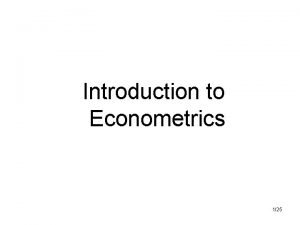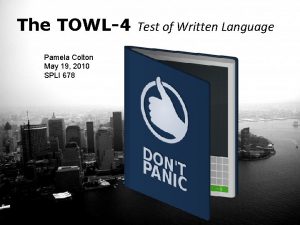TOWL Econometric Institute Erasmus School of Economics Erasmus

- Slides: 1

TOWL Econometric Institute Erasmus School of Economics Erasmus University Rotterdam THE TOWL ONTOLOGY LANGUAGE • Temporal extension to OWL-DL • Representation of time and temporal information • Allows for automated reasoning in a temporal context • Concrete domains for the representation of time in its quantitative nature (intervals) • Perdurantist approach for the representation of temporal information (change, state transitions) Time-determined ontology-based information system for real-time stock market analysis APPLICATION 1: STOCK WATCHER A web application that enables the extraction of relevant news items from RSS feeds concerning the NASDAQ-100 listed companies. The application's goal is to present a customized, aggregated view of the news categorized by different topics, while also giving an assessment of the impact hereof on stock prices. STOCK WATCHER - MAIN FEATURES: • Customizable user portfolio • Categorization of news items in one of the 4 available categories: company, competitors, important people, and primary industry • Impact assessment of individual news items on the stock price of the involved company Figure 1. TOWL Layer Cake. THE TOWL LAYER CAKE TOWL is based on a layered approach for the addition of temporal expressiveness to OWL-DL (Figure 1). OWL-DL forms the basis of the current approach towards representing time in Web Information Systems. As far as static information is concerned, TOWL maintains full backwards compatibility with OWL-DL. Concrete Domains as an extension to OWL-DL enable the representation of time. The concrete domain employed for the current purpose is the set Q of rational number together with the < and = predicates. Extending upon OWL-DL, we add to the expressive power of the latter by enabling n-ary predicates over functional role chains. Time Representation relates to enabling temporal expressions in the language. In this context, the concept of time is employed to refer to: • Representations of time in the form of instants and intervals • Representation of Allen’s 13 interval relations The representation of Allen’s 13 interval relations is enabled by a translation of these predicates in terms of elements of the domain Q of the concrete domain and its 2 predicates: < and =. Timeslices/Fluents stand at the fundament of our approach for representing temporal information. The main components of temporal information in the current context relate to: • Representing change • Representing state transitions The approach employs timeslices for representing temporal parts of an individual over certain time intervals while fluents indicate the changing aspect(s) across those intervals. Figure 2. Stock Watcher Output. APPLICATION 2: CONSENSUS AGGREGATOR The Consensus Aggregator system is built to support two main processes: i) the process of gathering and storing market advices given by brokers, and ii) the process of aggregating market advices into a single advice. CONSENSUS AGGREGATOR - MAIN FEATURES: • Basic temporal reasoning regarding the temporal validity of individual advices • Using historical information for determining the performance of individual brokers • Advanced methods for taking into account individual brokers’ experience in specific sectors Figure 3. Consensus Aggregator Performance. ACKNOWLEDGEMENT The authors are partially supported by the EU funded IST STREP Project FP 6 -26896: Time-determined ontology-based information system for real-time stock market analysis (TOWL). More information is available on the official website of the TOWL project (http: //www. towl. org/). Viorel Milea milea@few. eur. nl Econometric Institute Flavius Frasincar frasincar@few. eur. nl Erasmus University Rotterdam Uzay Kaymak kaymak@few. eur. nl Erasmus School of Economics PO Box 1738, 3000 DR, Rotterdam, the Netherlands TOWL Project: http: //www. towl. org/

